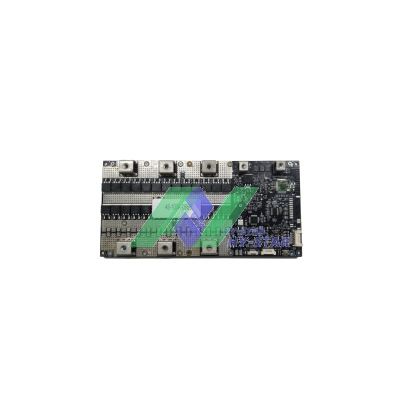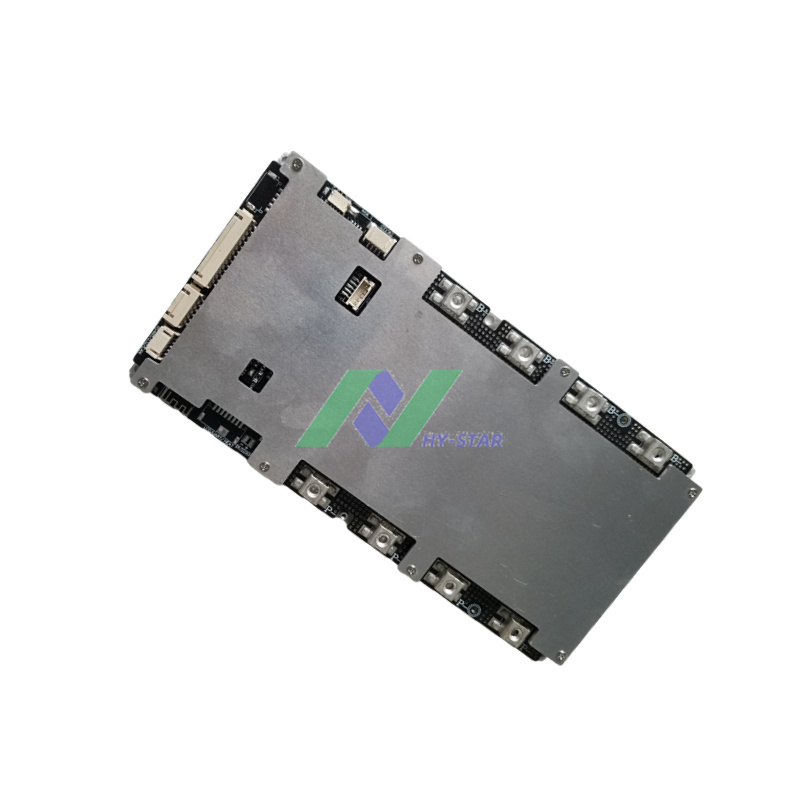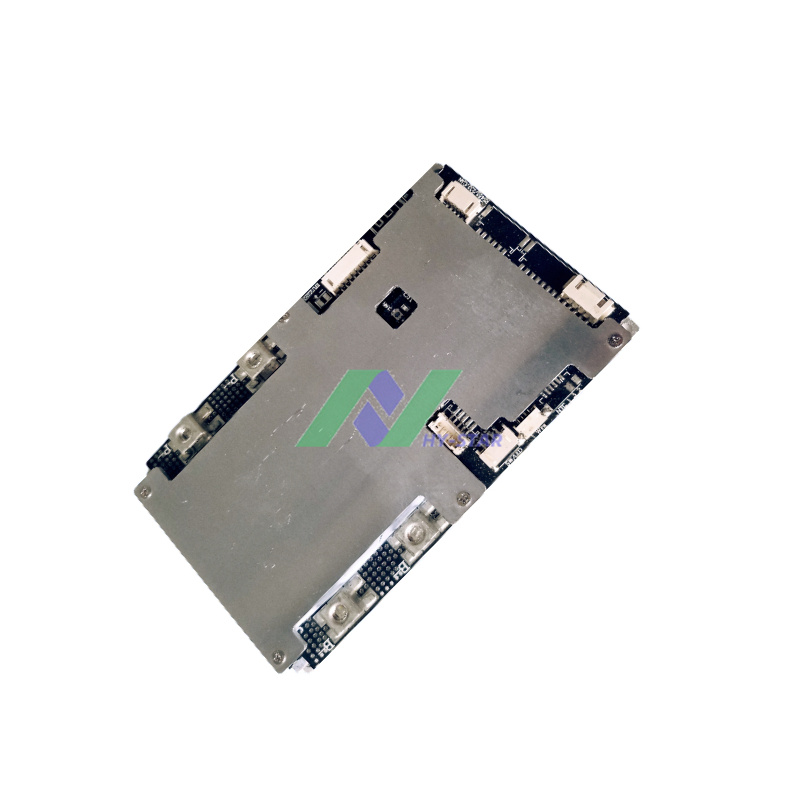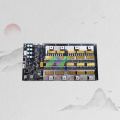Welcome to Haiye Technology (Shenzhen) Co., Ltd
E-mail: fpwangsz@haiyetech.com
View large
DS58L-4S-100A
PCBA size: 210x100xx25mm, including M5 terminal blocks.
Any chemical battery with 4 - 8 series, rated discharge of 100A, common port, with equalization. Equipped with Bluetooth mobile - end monitoring, low - voltage switch, pre - heating function for charging, LCD screen, and LED power indicator (optional).
Application scope: Vehicle - mounted inverters, low - speed vehicles, RV energy storage batteries, electric forklifts, etc.
- INFORMATION
- VIDEO
- RELATED
Main Functional Features
1. There is an upper computer software for PC - side monitoring, with isolated RS232 / isolated RS485 / isolated RS422 / isolated UART and isolated CAN interfaces, as well as non - isolated SMBUS communication. It is convenient to connect with a computer to read parameters such as single - cell battery voltage, total capacity, charge - discharge cycle times, battery pack temperature, SOH, SOC, etc.
2. There is a mobile Bluetooth client, and the status of the battery pack can be monitored by installing an APP software on the mobile phone.
3. Protection parameters can be flexibly edited and modified. They are saved in the storage chip, and the data can be stored for 50 years without loss.
4. The high - precision coulomb counter has temperature compensation, self - discharge compensation, and a learning function. After successful learning, the capacity accuracy can reach an error of 5%.
5. 16 - bit high - precision current and voltage sampling. This improves the sampling accuracy and performance of the BMS.
6. It automatically recovers 10 seconds after over - current, and there is no need to disconnect the load. By default, it does not automatically recover after over - discharge (automatic recovery can be selected).
7. After short - circuit protection, the load must be disconnected.
8. Supports JEITA intelligent chargers, perfectly protecting the safety of battery charging and greatly extending the battery life (optional).
9. With pre - discharge and pre - charge functions, it can reduce the spark when the customer connects (optional).
10. Charge - discharge temperature protection.
11. Built - in event fault recording black box function, which records data such as the highest voltage, lowest voltage, and over - current situation during battery use (optional).
12. With a secondary protection function (only effective for continuous current less than 30A), a battery permanent failure protection function (FUSE function), ensuring the safety of the battery at all times (optional).
13. A perfect passive equalization circuit to prevent serious overheating of the equalization circuit.
14. There is a weak - current switch to independently control the discharge circuit, eliminating large - current control components, saving costs and extending the service life of components (optional).
15. With LED capacity display function (optional).
16. With LCD capacity display function (optional).
17. With a low - temperature heating function (1 - 20A) (optional).
### Special Notes:
1. If it does not recover to the over - discharge recovery voltage within 10 seconds after over - discharge, it enters the power - off and shutdown state, consuming less than 15 micro - amperes of current. It must be activated by a charger.
2. For over - discharge and over - current, there is a self - recovery function after 30 seconds, and there is no need to disconnect the load. The load needs to be disconnected for overload and short - circuit.
3. For LED capacity display, when there is a charging current and it is greater than 200 mA, the capacity display lights up automatically. When there is no charging current, the capacity display turns off automatically. During discharge, if the capacity needs to be displayed, press the light - touch switch, and the capacity will be displayed for 5 seconds and then automatically turn off to save power.
4. For LCD capacity display, the capacity is always displayed whether charging or discharging (very power - saving).
5. For charging records, continuous charging to more than 90% of the capacity until full and with a current greater than 500 mA is regarded as one charge. For discharge records, after stopping discharging more than 90% of the capacity, the current discharge will start to be recorded. This is to prevent excessive records due to continuous intermittent discharging.
6. After the BMS installs the sampling wire for the first time, the start switch must be pressed (or the charger must be inserted) for the BMS to work properly.
7. For SOC capacity indication, the BMS estimates the battery capacity when it is just powered on. It needs to complete two full charge - discharge cycles (note: during learning, the maximum current should not exceed 0.5C). The BMS will learn the capacity by itself, and the capacity is the most accurate at this time.
8. The BMS has a standard RS232 communication interface. There is no need for an expensive adapter board. Only an RS232 - to - USB cable is needed to connect to the PC - side USB interface.
9. The RS232 - to - USB adapter cable must be installed with the correct driver before it can be connected to the upper computer on the laptop. (For the installation method, please refer to the product specification.)
1. There is an upper computer software for PC - side monitoring, with isolated RS232 / isolated RS485 / isolated RS422 / isolated UART and isolated CAN interfaces, as well as non - isolated SMBUS communication. It is convenient to connect with a computer to read parameters such as single - cell battery voltage, total capacity, charge - discharge cycle times, battery pack temperature, SOH, SOC, etc.
2. There is a mobile Bluetooth client, and the status of the battery pack can be monitored by installing an APP software on the mobile phone.
3. Protection parameters can be flexibly edited and modified. They are saved in the storage chip, and the data can be stored for 50 years without loss.
4. The high - precision coulomb counter has temperature compensation, self - discharge compensation, and a learning function. After successful learning, the capacity accuracy can reach an error of 5%.
5. 16 - bit high - precision current and voltage sampling. This improves the sampling accuracy and performance of the BMS.
6. It automatically recovers 10 seconds after over - current, and there is no need to disconnect the load. By default, it does not automatically recover after over - discharge (automatic recovery can be selected).
7. After short - circuit protection, the load must be disconnected.
8. Supports JEITA intelligent chargers, perfectly protecting the safety of battery charging and greatly extending the battery life (optional).
9. With pre - discharge and pre - charge functions, it can reduce the spark when the customer connects (optional).
10. Charge - discharge temperature protection.
11. Built - in event fault recording black box function, which records data such as the highest voltage, lowest voltage, and over - current situation during battery use (optional).
12. With a secondary protection function (only effective for continuous current less than 30A), a battery permanent failure protection function (FUSE function), ensuring the safety of the battery at all times (optional).
13. A perfect passive equalization circuit to prevent serious overheating of the equalization circuit.
14. There is a weak - current switch to independently control the discharge circuit, eliminating large - current control components, saving costs and extending the service life of components (optional).
15. With LED capacity display function (optional).
16. With LCD capacity display function (optional).
17. With a low - temperature heating function (1 - 20A) (optional).
### Special Notes:
1. If it does not recover to the over - discharge recovery voltage within 10 seconds after over - discharge, it enters the power - off and shutdown state, consuming less than 15 micro - amperes of current. It must be activated by a charger.
2. For over - discharge and over - current, there is a self - recovery function after 30 seconds, and there is no need to disconnect the load. The load needs to be disconnected for overload and short - circuit.
3. For LED capacity display, when there is a charging current and it is greater than 200 mA, the capacity display lights up automatically. When there is no charging current, the capacity display turns off automatically. During discharge, if the capacity needs to be displayed, press the light - touch switch, and the capacity will be displayed for 5 seconds and then automatically turn off to save power.
4. For LCD capacity display, the capacity is always displayed whether charging or discharging (very power - saving).
5. For charging records, continuous charging to more than 90% of the capacity until full and with a current greater than 500 mA is regarded as one charge. For discharge records, after stopping discharging more than 90% of the capacity, the current discharge will start to be recorded. This is to prevent excessive records due to continuous intermittent discharging.
6. After the BMS installs the sampling wire for the first time, the start switch must be pressed (or the charger must be inserted) for the BMS to work properly.
7. For SOC capacity indication, the BMS estimates the battery capacity when it is just powered on. It needs to complete two full charge - discharge cycles (note: during learning, the maximum current should not exceed 0.5C). The BMS will learn the capacity by itself, and the capacity is the most accurate at this time.
8. The BMS has a standard RS232 communication interface. There is no need for an expensive adapter board. Only an RS232 - to - USB cable is needed to connect to the PC - side USB interface.
9. The RS232 - to - USB adapter cable must be installed with the correct driver before it can be connected to the upper computer on the laptop. (For the installation method, please refer to the product specification.)
Please send a product inquiry and we will address your concerns as soon as possible.
-
Phone
+86 13410750168 -
Wechat




